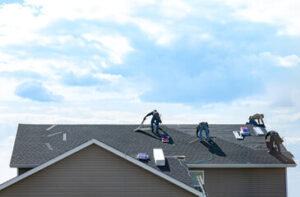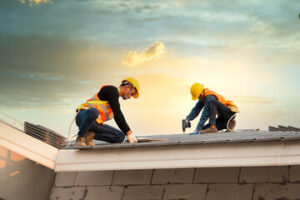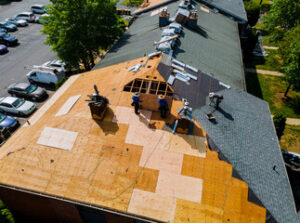Many homeowners are unaware that their roof needs repair until something drastic goes wrong. That’s why it’s important to periodically check shingles, gutters and roof edges for signs of leakage.

In addition to assessing the condition of the shingles, you should also look for leaks and water damage inside the home, particularly around ceilings, cabinets, windows and chimneys. A leaking roof can cause mold and mildew, so it’s essential to catch the problem quickly. Contact Roof Repair Columbus GA for professional help.
Depending on the type of roof, location and extent of damage, there are many factors that can influence repair costs. Shingle repairs are the most common, and can range in price from a few missing shingles to a full roof replacement. Asphalt shingle roofs are relatively inexpensive to install, but can be damaged by hail and wind. Damaged shingles are easy for homeowners to fix with roofing cement and caulking, but bigger problems may require professional help.
Another major expense is the cost of labor for repairing leaks. Most roofing companies charge $45 to $75 per hour for labor. Homeowners can save money by searching “roof repair near me” online to find local prices. If a roof has extra features like a skylight or chimney, these can add to the repair bill. Repairing a skylight or chimney could involve replacing the flashing, which is the metal material that runs around the edges of your roof and funnels water into gutters. This element often rusts or fails, leading to leaks, and should be left to a professional who can inspect your roof to determine what needs to be done.
A sagging roof requires more extensive and expensive repairs, as it can cause structural issues with your house. A pro can evaluate the problem and design a plan to stabilize it, which typically involves securing trusses, rafters and repairing or replacing roof decking, underlayment and insulation. A full roof replacement can cost $1,500 to $7,000.
It’s important to consider whether a re-do is worth the investment. A new roof can provide better energy efficiency and durability than an old one, and it might also be more affordable in the long run if you’re considering a move to a different climate. It’s also a good idea to consult your homeowners insurance to see if your repair or replacement is covered.
Other costs associated with a roof include the price of materials and labor for a full replacement. The type of roof will impact these prices, as some materials are more insulative and durable than others. Other factors that can affect repair or replacement costs are the roof’s age, damage extent and budget limitations.
Materials
The materials used in roof repair are a key factor in determining the cost of the job. Different roofing materials have different qualities, which affect their durability and lifespan. Some are more durable than others, and some require a specific type of installation or repair method. The cost of the material will also vary based on its availability. For example, a slate roof will be more expensive than an asphalt shingle roof. The type of roofing material can also influence the price of materials for other components, such as flashing or sealants.
Flashing is the metal or plastic material that seals the intersections of the roof, including those around chimneys and vents. It is important to check and fix flashing problems regularly to prevent water infiltration and damage. Metal flashing is usually installed with a neoprene rubber gasket to ensure a waterproof seal. Depending on the roof and wall materials, the flashing may be integrated into the shingles or embedded in the brick or stucco of the wall.
Other types of flashing include mechanical or metal pipe boots, which seal the areas where pipes enter a home’s roof. These fixtures are a vital part of the ventilation system for household appliances like dryers and furnaces. The pipe boots should be replaced whenever they’re damaged, as they can allow water to infiltrate the roof and cause damage.
A leaking roof is not only unsightly, but it can also be dangerous. A professional roofer should be able to identify the source of the leak and make the necessary repairs. He or she should also be able to clean and inspect the roof for any other damage that requires attention.
Whether the roof is made of wood or some other material, the structure should be examined for soft spots and rot. If left unattended, these soft spots can lead to the breakdown of even the most durable roofing materials. The rotting wood provides a moisture haven, which can foster the growth of mold and fungus and accelerate the deterioration of the roof’s shingles.
To assess the condition of the roof, a pro should start by covering the area to be repaired with a tarp. The tarp should be long enough to reach the peak of the roof and extend several feet beyond the problem area. If the tarp is positioned on a sloped roof, the pro should secure it with roofing nails and tuck it under the eaves.
High-demand season
Choosing the right time of year to tackle roof repair can have significant financial implications. Understanding the pros and cons of different seasons is an essential step in reducing costs and making sound investments.
Typically, roof repair contractors experience peak season during the spring and summer months. This period offers favorable weather conditions and high homeowner demand. However, these factors can also result in higher prices and scheduling challenges. In addition, the intense heat of summer can affect the working hours of roofers and damage roofing materials like asphalt shingles.
Fall is an unexpectedly opportune season for addressing roof repair needs. The cooler temperatures and impending winter motivate homeowners to get their repairs done quickly. This can help them save money and prevent serious issues in the long run. Additionally, roofing companies can work more efficiently in the winter due to decreased workload. Moreover, roofing contractors are less likely to cause damage to landscapes in the winter because trees and flower beds are dormant.
Inspection
A professional roof inspector will examine your roof from the ground and on a ladder, if necessary. They will look for shingles, tile or slate that are cracked, curled or missing granules. They will also check for shingle valleys and joints, as well as rot or other water damage in these areas. They will also inspect the attic for signs of mold and pest infestations, as well as water stains on the ceiling or walls.
Inspectors will also check the thin, metal flashing that lines penetrations such as skylights, chimneys and vent pipes. These can leak, which can cause structural damage to the roof and to the interior of your home. If the flashing is damaged, it should be removed and re-bent before a new piece is fixed in its place. Inspectors will also check fascia boards and soffit boards, which cover the underside of a roof overhang, for rot, cracks or warping. If these are damaged, they must be replaced.
The inspector will also inspect gutters for rust, holes or clogging. These are essential to siphoning off rainwater and preventing the water from seeping into the roof structure. If they become clogged, they can put unnecessary stress on the roof, which can lead to a prematurely ripped-off or collapsed roof.
Leaky roofs are the most common problem encountered by homeowners. They can be difficult to identify, but they typically manifest as dripping water, staining on the ceiling or walls, and sagging in the attic. It is important to get any issues identified and addressed as soon as possible to avoid major problems.
Most home inspectors are not roofing experts, so they will often recommend that you follow up with a roof inspection by a roofing professional. This can be a good idea, especially if you are considering selling your house in the future. Home buyers will want to know that the roof is in good condition and that any problems have been identified and addressed. It is also a good idea to get the roof inspection results in writing. It will help you document the condition of your roof and may be required by your insurance company when you change or renew your policy.

